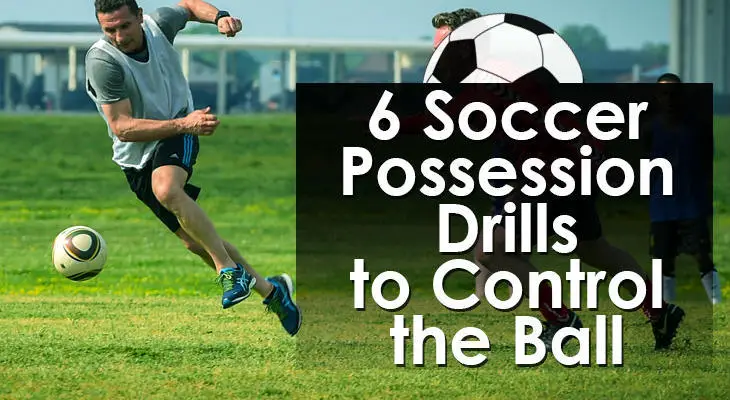8 Soccer Possession Drills (2024 Update)
In order to score, your team must have possession of the soccer ball.
That's why it's incredibly important to use soccer possession drills during your training sessions to teach your team how to keep possession for as long as possible.
There are two main skills these soccer drills work on:
- Quick decision making.
- Ball control in tight spaces.
If your team can master those skills, your team will have a much greater opportunity to dominate the game and put the ball in the back of the net.
Implement the following 6 soccer possession drills to see an increase in your team's performance.
8 Soccer Possession Drills
1. 4v4+3 Barcelona
How the Drill Works:
Two teams of four play possession with three neutrals. Teams must repress and transition from defense to offense quickly to be successful. Teams are awarded points for consecutive passes.
Purpose:
Develop players’ ability to repress the ball when they immediately turn it over. Players improve their transition speed from defense to offense as well as their possession skills.
Setup:
- Use cones to mark a 25x20 yard rectangle.
- Select three players to start as neutrals. These players should be good in possession. Assign them a jersey color. One neutral player starts inside the playing area while the remaining two neutrals start on opposite end lines.
- The remaining players are divided in to teams of four. If there is an odd number of players have players rotate every game. If there are 12 players, make three teams and rotate teams after every round.
- Assign different colored jerseys to each team. One team starts inside the playing area as defense while the other team starts on the outside as the offense team. The offense team should have two players on each sideline. See diagram below for more information.
- Gather all the soccer balls and place them outside the playing area.
- The coach should stand next to the soccer balls to pass new balls in as needed.
- Decide on the number of rounds. Play at least five rounds of 2-3 minutes.
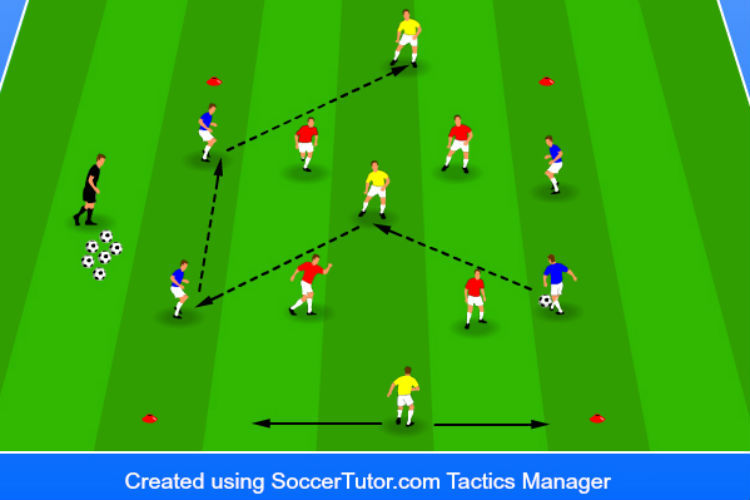
Instructions:
- To start the activity, the coach passes a ball to the offensive team on the outside.
- The offensive team, plus the three neutral players, attempt to keep possession of the ball as the defensive team tries to win the ball.
- Eight consecutive passes earn the offensive team one point.
- When the defensive team wins the ball, they quickly transition to the outside of the playing area while connecting passes with their teammates and neutral players.
- When the offensive team loses possession, they should immediately repress and attempt to win the ball back before their opponents can transition and get organized on the outside of the playing area.
- The team in possession should always have two players on each sideline. The team playing defense should have four players inside the box.
- Players are allowed to move along their sideline and a yard or two inside. The neutral player in the middle of the box is free to move wherever.
- Play strict out-of-bounds lines. A new ball is started from the coach and is passed to the team that did not last touch the ball before it went out.
- Play at least five rounds of 2-3 minutes. Play more rounds as needed.
Variations:
Touch limit– Limit the number of touches players get. Three-touch, two-touch, or one-touch depending on the quality of the players.
Point system – Change the number of consecutive passes needed for a point. 10, 12, or 6 depending on the skill level of the players.
Space – Increase or decrease the size of the playing area to match the skill level of the group. Decrease the size to increase the speed of play. Increase the size to allow players more time on the ball.
Coaching Points:
- Teach the players to repress as soon as they lose the ball! Do not let the other team have time on the ball and spread out around the rectangle.
- Educate the players to move along their lines to create good passing angles and keep possession of the ball.
- Remind the players to focus on their body positioning so they can see the entire field and make quick decisions.
- Challenge the players to think multiple passes ahead and to keep the ball moving!
- Encourage the defenders to win the ball quickly and move as a group!
2. Blackjack
How the Drill Works:
Two teams attempt to connect 21 three-touch passes, 21 two-touch passes, and then 21 one-touch passes before their opponent does.
Purpose:
Develop players’ ability to keep possession and increase their speed of play. Players improve their decision making and their ball control in tight spaces.
Setup:
- Use cones to mark a 25x25 yard square. Adjust the size depending on the number of players and skill level.
- Divide the players in to two teams. Assign each team a different colored jersey.
- All the players start in the box.
- Gather all the soccer balls on one side of the box.
- The coach should stand next to the soccer balls to pass new balls in as needed.
- Decide on the number of rounds. At least three rounds are suggested.
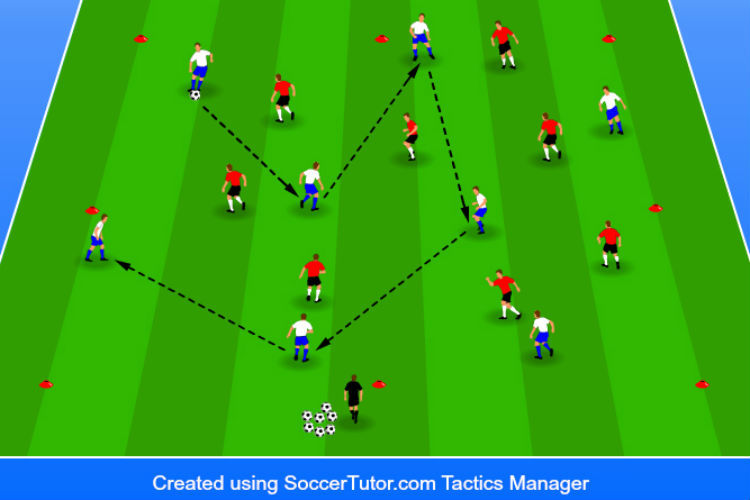
Instructions:
- The coach passes a ball in to the box to either team.
- The two teams attempt to keep possession of the ball and connect passes.
- Each team attempts to connect 21 three-touch passes, and 21 two-touch passes, and then finish the game by connecting 21 one-touch passes.
- Teams count their own passes. Teams can not move to two-touch passes until they complete the 21 three-touch passes.
- Passes do not need to be consecutive. If a team completes 10 passes and then loses possession, they will start at 10 when they win possession again.
- The first team to complete each level of passing wins the round!
- Gather the balls and rest after each round. Play three rounds. Add more rounds as needed.
Variations:
Touch limit– Limit the number of touches players get. Max the number of touches to the level the players are trying to complete. Two-touch passing means players only get two-touches.
Counting – When players get to one-touch passing, give players three, or two-touch, but only count the passes that are completed in one-touch.
Neutral players – Add neutral players to move the game along if teams are struggling with possession and connecting passes. Add one or two neutral players as needed.
Coaching Points:
- Teach the players to make the space as big as they can by spreading out throughout the box! This will stretch the defense and allow players more time on the ball.
- Educate the players on their body positioning. Players should keep their bodies open and be able to see as much of the field as possible.
- Challenge the players to think quickly and move the ball! Keep the defenders moving!
- Encourage the defending team to win the ball back quickly and expand to transition into offense.
3. Break the Line
How the Drill Works:
Two teams play possession inside the playing area while attempting to complete an up-back-through to break the end line and score.
Purpose:
Develop players’ ability to move the ball and set up opportunities to complete an up-back-through to goal. Forces players to think multiple passes in advance. Players increase their possession skills as well as their ability to make runs off the ball.
Setup:
- Use cones to mark a 40x40 yard playing area. Adjust the size depending on the number of players and skill level. Position the grid in the middle of the field if possible.
- Set up two goals on each end line of the full-sized field. If a full-sized field is unavailable, position the playing area in the middle of the available space with a goal 10-20 yards away from two of the sides of the playing area.
- Select four players to start as neutral players. Assign a separate jersey color to them. Have the neutral players divide along the two sidelines of the playing area that the goals area located behind. See diagram for a better understanding.
- Divide the remaining players in to two teams of five players. Assign each team a different colored jersey. Both teams start inside the playing area.
- If available, position one goalkeeper in each goal.
- Gather all the soccer balls and place them outside the playing area.
- Have the coach stand near the soccer balls to pass a new ball in as needed.
- Decide on the number of rounds and time limit for each round. At least three rounds of 4-6 minutes are suggested.
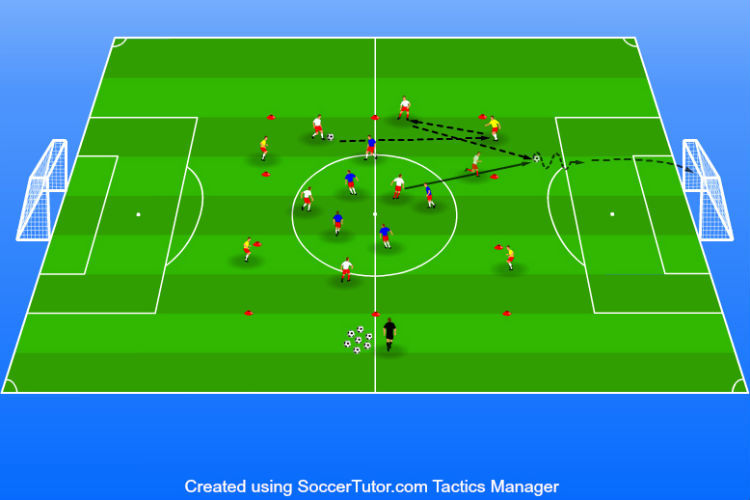
Instructions:
- To start the activity, the coach passes a ball in to either team.
- The team in possession attempts to pass and move the ball inside the playing area until they are able to complete an up-back-through with one of the neutral players on either side of the playing area.
- A team is awarded a point if they can complete an up-back-through and score on goal. Players must stay onside when completing the up-back-through in order for the point to count.
- The team not in possession of the ball attempts intercept the ball and take possession of the ball.
- Teams are allowed to attack either goal when in possession. Neutral players can be used to help keep possession of the ball for the team in possession. If the ball goes out-of-bounds for any reason, a new ball is started from the coach and is given to the team that did not last touch it.
- Play at least three rounds of 4-6 minutes. Give 1-2 minutes of rest between each round to gather soccer balls and recover. Switch neutral players after each round.
Variations:
Number of players – Play 6v6 or 7v7 depending on number of players available. Adjust the size of the playing area accordingly.
Touch limit – Limit the number of touches players get. Three-touch, two-touch, or one-touch depending on the quality of the players.
Pass Rule – Teams must complete three, four, or five passes before being able to break out of the box.
Coaching Points:
- Teach the players to use the entire playing area to create openings.
- Educate the players on the up-back-through pattern and different ways to complete the pattern.
- Remind the players the game-like application of this activity. Players playing forward to their striker, receiving a lay-off, and then playing a through ball to a playing breaking past the defenders.
- Challenge the players to think multiple passes in advance.
- Encourage the players to constantly move and create good angles of support.
- Challenge the defending team to win the ball back quickly and transition into offense!
4. English Squares
How the Drill Works:
Two squares are set up with one team of five players in each square. The third team, in neither box, sends two of its players into one of the boxes and attempts to win the ball from the offensive team. If the offensive team completes six passes, they pass the ball to the other square for the game to continue. If the defensive team wins the ball, they occupy that square and the team last lost it now defends.
Purpose:
Develop players’ ability to connect passes in a tight area. Players increase their possession skills and speed of play.
Setup:
- Use cones to mark two 20x15 yard boxes. There should be 10 yards of space between the two boxes.
- Divide the players into three teams of five players. Assign each team a different colored jersey.
- Assign one team to each box with the third being assign to the space between the two boxes.
- Gather all the soccer balls and place them outside the playing area.
- The coach should stand next to the soccer balls to pass new balls in as needed.
- Decide on the number of rounds. Play at least three rounds of 4-6 minutes.
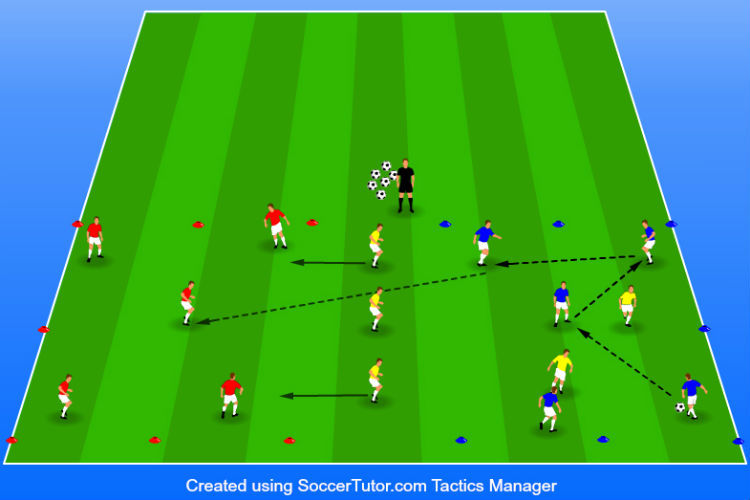
Instructions:
- To start the activity, the coach passes a ball to either team positioned inside a box.
- As soon as the team receiving the pass takes their first touch, two defenders can enter the area and attempt to win the ball.
- The team in possession attempts to connect six consecutive passes before passing the ball across the middle to the opposite box.
- Teams are awarded one point each time they successfully complete their number of passes and pass the ball to the opposite box.
- Defenders prevent the offensive team from scoring by winning the ball and passing it across to the other box, or if the ball goes out-of-bounds for any reason. The offensive team is free to try and win the ball back until the ball goes out of their box.
- If the defensive team wins the ball, or the ball goes out-of-bounds, the team that lost the ball becomes the new defensive team and moves to the space between the two boxes. The team that successfully defended now positions themselves in the box the other team just left.
- A new ball is started from the coach and is passed to the team in the opposite box the ball was just in and the process continues.
- If the offensive team completes their six passes and plays the ball to the other box, the two defenders go back to the middle space, and two new defenders enter the opposite box.
- Defenders in the middle space can not block passes as they go across the middle space.
- The game continues in this manner for 4-6 minutes before teams rest and recover all the soccer balls. Play at least three rounds. Add more rounds as needed.
Variations:
Numbers – Divide in to three evenly numbered teams. Teams of seven, six, or four are all possible. Adjust the size of the boxes accordingly.
Number of defenders – Send more defenders into the offensive box if the teams are connecting too easily.
Middle space defenders – Allow the middle space defenders to block and passes that come through the middle. This will make it more difficult to play across to the other box. Decide if players can play the ball over in the air or on the floor then.
Touch limit– Limit the number of touches players get. Three-touch, two-touch, or one-touch depending on the quality of the players.
Point system – Change the number of consecutive passes needed for a point. Eight, ten, or five depending on the skill level of the players.
Space – Increase or decrease the size of the playing area to match the skill level of the group. Decrease the size to increase the speed of play. Increase the size to allow players more time on the ball.
Coaching Points:
- Remind the players to constantly move off of each other to create space and good angles of support to keep possession of the ball.
- Educate the players to be patient with ball. If the pass can not be easily completed to the other box at six passes, encourage the team to keep moving the ball until the pass can be made.
- Challenge the players to think quickly and to keep the ball moving so the defenders do not have a chance to steal it.
- Encourage the defenders to win the ball quickly and move as a group!
5. Four Quadrant
How the Drill Works:
Two teams play possession inside a playing area that is divided into four quadrants. Teams are only allowed to connect a certain number of passes in a quadrant before they must move to another quadrant or turn the ball over.
Purpose:
Develop players’ ability to keep possession of the ball while moving throughout the playing area. Players are asked to constantly change areas the ball is being possessed to keep the ball. Players must think 1, 2, or 3 passes ahead to succeed.
Setup:
- Use cones to mark a 30x30 yard playing area. Adjust the size depending on the number of players and skill level.
- Inside the playing area, divide the space into four even quadrants using a couple of cone. Make sure there enough cones that players can see the quadrants, but not too many that the cones will get in the way.
- Divide the players in to two teams. Assign each team a different colored jersey.
- All the players start inside the playing area.
- Gather all the soccer balls and place them outside the playing area.
- Have the coach stand near the soccer balls to pass a new ball in as needed.
- Decide on the number of rounds. At least three rounds of 4-6 minutes are suggested.
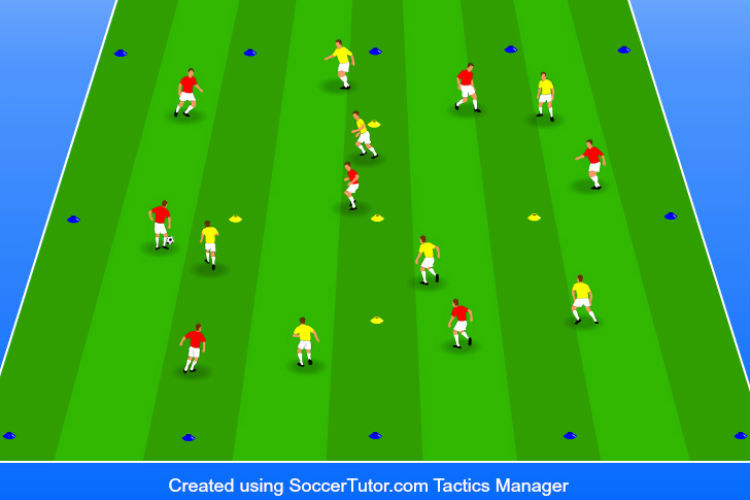
Instructions:
- To start the activity, the coach passes a ball in to either team.
- The two teams attempt to keep possession and connect passes while the other team attempts to win the ball back.
- Teams are awarded one point every time they complete eight passes.
- Teams can only complete four consecutive passes in one quadrant before they must pass and move to another quadrant. If teams complete more than four consecutive passes in one quadrant, they lose possession of the ball and must pass it to the other team.
- If the ball goes out-of-bounds, a new ball is started by the coach and is passed to the team who did not last touch the ball.
- Play at least three rounds of 4-6 minutes. Give 1-2 minutes of rest between each round to gather soccer balls and recover.
Variations:
Number of players– Play 10v10, 8v8, 7v7, etc. Make sure to adjust the playing area as the number of players changes.
Touch limit– Limit the number of touches players get. Three-touch, two-touch, or one-touch depending on the quality of the players.
Neutral players – Add one or two neutral players to help teams possess and score. If teams are struggling to score or connect passes, add a neutral player.
Quadrant rule – Adjust the number of consecutive passes in the quadrant to increase or decrease the difficulty.
Coaching Points:
- Teach the players to use the entire playing area and spread out to stretch the defense and create more space for their teammates. Make sure players are not hiding or moving even if they are further away from the ball.
- Educate the players that they need to think 1, 2, or 3 passes ahead to keep the ball moving from one quadrant to the other.
- Remind the players to give good angles of support and constantly readjust their field and body positioning.
- Encourage the team in possession to mix short passes with long passes to draw defenders in and then spread them out!
- Challenge the defending team to win the ball back quickly and transition into offense!
6. Golf Possession
How the Drill Works:
Two teams play possession and score points by passing the ball to one of their teammates standing inside their team boxes.
Purpose:
Develop players’ ability to keep possession of the ball and move the ball directionally as a team. Players improve their intelligence and movement as they work to find space for their teammates.
Setup:
- Use cones to mark a 30x30 yard square. Adjust the size depending on the number of players and skill level.
- Use cones to mark four 4x4 yard boxes just inside each corner of the square. See diagram below for more information.
- Divide the players in to two teams. Assign each team a different colored jersey.
- Have two players from each team start inside a small box inside the playing area. Teammates should occupy boxes that are diagonal from each other.
- The remaining players start inside the playing area.
- Gather all the soccer balls and place them outside the playing area.
- The coach should stand next to the soccer balls to pass new balls in as needed.
- Decide on the number of rounds. At least three rounds of 4-6 minutes are suggested.
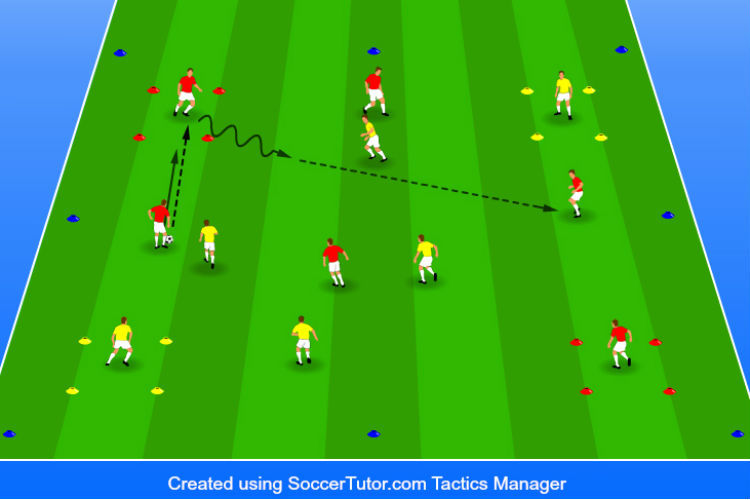
Instructions:
- The coach passes a ball in to the box to either team to start the round.
- The two teams attempt to keep possession while moving the ball to find one of their teammates standing in a box.
- When a team successfully completes a pass to one of their teammates inside a box, that team is awarded one point.
- The player who receives the pass dribbles out of the box and attempts to keep possession of the ball. The player who passed the ball in to the box, now takes the place of the teammate who left the box.
- Teams attempt to score as many points as they can each round. Team with the most points at the end of the round is the winner.
- Play at least three rounds of 4-6 minutes. Give 1-2 minutes of rest between each round to gather soccer balls and recover.
Variations:
Number of players– Play 8v8, 7v7, 6v6, etc. Make sure there is one player in each of the two team boxes.
Touch limit– Limit the number of touches players get. Three-touch, two-touch, or one-touch depending on the quality of the players.
Neutral players – Add one or two neutral players to help teams possess and score. If teams are struggling to score or connect passes, adding one neutral player is suggested.
Coaching Points:
- Educate the players to constantly move and create space for their teammates. Moving into space will create more time for the player on the ball and increase the team’s possession.
- Teach the players to give good angles of support to their teammates. Proper angles will allow teammates easier passes and keep the defense moving.
- Challenge the players to think 1, 2, or 3 passes ahead. This will allow players to move off of each other and move the ball to score points.
- Encourage the defending team to win the ball back quickly and transition into offense!
7. Progressive Passing Box
How the Drill Works:
The team in possession tries to progress the ball through each channel to the opposite side of the field. The ball cannot skip a segment, forcing the players to work through each phase methodically.
Purpose:
The purpose of this drill is to develop the skill set needed to not only keep the ball, but to progress it in a controlled and measured way.
Setup:
Create a square grid using cones spread around 20 yards apart.
Divide the grid into halves and make sure to clearly mark the halfway line.
Two designated defenders stand inside the grid and are free to move around as they please.
Six attackers are given different roles:
Two stand outside the grid on one end
Two stand outside the grid on the other end
Two stand inside the grid
Attacking players must stay in their assigned positions

Instructions:
The ball starts outside the grid with one of the attacking players.
On the coach’s signal, the game goes live.
The attacking team tries to move the ball to the opposite side of the grid, however, the ball must pass through each segment (it can’t skip a section).
They can pass it back to their teammates on the outside if necessary.
If the attackers lose possession or the defenders win it, the attacking team must restart the drill.
Every time the attackers successfully move the ball from one side to the other, they score a goal.
Run the drill for two minutes at a time.
Rotate player roles after each round.
Whichever team finishes with the most points wins.
Variations:
Defender boost - Add more defenders to make the drill more difficult.
Adjust grid size - Increase or decrease the size of the grid, depending on the performance of your players.
Limit touches - Introduce a two-touch rule for the attacking team, encouraging quick passing and movement.
Coaching points:
Players may be tempted to rush passes as the grid can feel cramped. However, you want them to stay calm and composed. Be sure to allow players to make mistakes and gradually feel their way into the drill.
This drill may seem easy on paper, but in reality, it can be difficult, especially for young players. If the attacking team is struggling, instruct the defenders to play passively without actually trying to win the ball.
The key skills to look out for among your attacking players are first-touch, hold-up play, quick passing, and movement.
With this drill, you may have to run it for a few weeks before seeing results, but it’s worth the effort. Your players will become much more confident and competent passers, especially in the build-up phases.
8. Possession Deposits
How the Drill Works:
Two teams compete to deposit balls into their designated squares. Before a ball can be deposited, the team must make three consecutive passes. Once the ball is deposited, it can’t be removed. The coach introduces a new ball after each round. When the time is up, the team with the most deposits wins.
Purpose:
Teams work in threes to keep the ball from an aggressive press. The absence of goals means players can fully focus on completing their passes and depositing balls.
Setup:
Create a 20 x 15-yard mini-field.
Create four small squares with cones - these will be your deposit zones.
If you have two different colored cones, use them - each team is assigned two deposit zones.
Split your team into groups of three.

Instructions:
Before each round, assign two deposit zones to each team.
The coach stands outside the grid with multiple balls.
To start the drill, the coach kicks the ball into the grid.
The teams compete to win the ball and then try to complete three consecutive passes.
Once a team completes three consecutive passes, they can score a point by placing the ball into one of their deposit zones. The defensive team can try to stop them until the ball is in the square.
Once the ball goes into the square, it can’t be removed.
After a point is scored, the coach kicks another ball into the grid and the drill continues.
Once the time limit elapses (around five minutes), the team with the most balls in their deposit zones wins.
Variations:
Change the number of squares - Add more squares or reduce the number of squares, depending on whether you want to make the drill easier or harder.
Two ball - Play the drill with two balls per round. This is only recommended for advanced players or if you want to have some fun as it can get chaotic.
Tournament - If you have enough teams, create a knockout-style tournament.
Coaching points:
Movement and positioning are key as completing consecutive passes is just one part of the drill. To score a point, the team must successfully deposit the ball inside one of their designated squares, so the actions following the passes are just as important.
After completing the three passes, a lot of players tend to rush and try to dribble the ball into the deposit square, abandoning the passing strategy. If this begins to happen, ban dribbling over five yards (unless the player is trying to escape a defender).
The drill can take some getting used to so give your players a few rounds to get into it. If it’s a slow start, take note of the main issues and provide clear and concise feedback.
What's Next?
There's no point keeping possession if your team can't put the ball in the back of the net!
Check out our favorite shooting drills -- along with our passing drills, defensive drills, and everything else -- on this link.

